Human metapneumovirus (HMPV) is currently making headlines in China due to a surge in cases. This respiratory virus, causing flu-like symptoms, has led to overcrowded hospitals, sparking fears of a new health crisis. Some social media posts even suggest the presence of other viruses, including influenza A, Mycoplasma pneumoniae, and COVID-19, further complicating the situation. Here’s everything you need to know about HMPV, its symptoms, and how it spreads. What Is HMPV? HMPV is a respiratory virus that causes infections in both the upper and lower respiratory tracts. It was […]

HMPV Outbreak In China: A New Health Threat
Human metapneumovirus (HMPV) is currently making headlines in China due to a surge in cases. This respiratory virus, causing flu-like symptoms, has led to overcrowded hospitals, sparking fears of a new health crisis. Some social media posts even suggest the presence of other viruses, including influenza A, Mycoplasma pneumoniae, and COVID-19, further complicating the situation. Here’s everything you need to know about HMPV, its symptoms, and how it spreads.
HMPV is a respiratory virus that causes infections in both the upper and lower respiratory tracts. It was first identified in 2001 and affects people of all ages. However, children, the elderly, and individuals with weakened immune systems are more vulnerable to severe illness. HMPV can lead to conditions such as bronchitis or pneumonia.
HMPV symptoms are similar to those of the flu and other respiratory infections. Common signs include:
In more severe cases, it can result in complications like pneumonia or bronchitis. The incubation period typically ranges from three to six days, with symptoms lasting a few days depending on the severity.
HMPV spreads through respiratory droplets when an infected person coughs or sneezes. Other common methods of transmission include:
Like other respiratory viruses, it is highly contagious, making prevention crucial.
Read More: US: Norovirus On The Rise, What You Need To Know About Its Spread, Symptoms, And Precautions
Certain groups are at a higher risk of severe illness from HMPV:
These groups are more likely to experience severe complications, such as pneumonia, if infected by the virus.
Preventing HMPV is similar to preventing other respiratory illnesses. Here are some important tips:
These habits can significantly reduce the risk of contracting the virus.
Read More: Buruli Ulcer: Flesh-Eating Bacteria Spreads Rapidly Across Australia
If you develop symptoms then the below mentioned steps you can take to reduce further transmission:
Currently, there is no specific antiviral treatment or vaccine for this virus. Medical care is supportive, focusing on managing symptoms and preventing complications. If you develop severe symptoms, it’s important to seek medical attention.
Both HMPV and COVID-19 are respiratory viruses that share many similar symptoms, including fever, cough, sore throat, and shortness of breath. Both viruses spread via respiratory droplets. However, HMPV tends to peak in the winter and spring, unlike COVID-19, which spreads year-round.
Studies indicate that after COVID-19 restrictions were lifted, HMPV cases tripled in some areas. The decreased exposure to viruses during lockdowns may have weakened immunity, causing a surge in infections once precautions were relaxed.
In conclusion, HMPV is a growing concern in China, and understanding how it spreads and how to protect yourself is vital. While there is no specific vaccine or antiviral treatment, following proper hygiene and preventive measures can reduce your risk of infection.



















